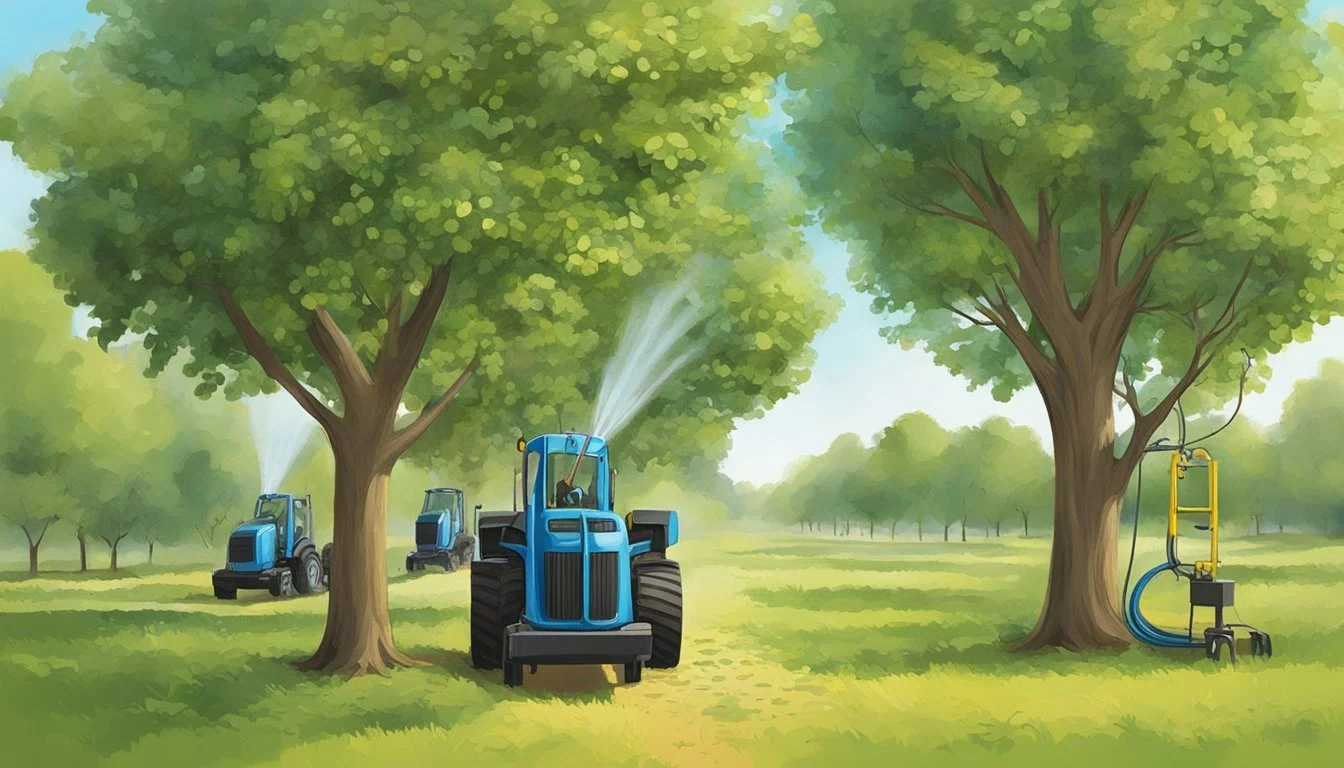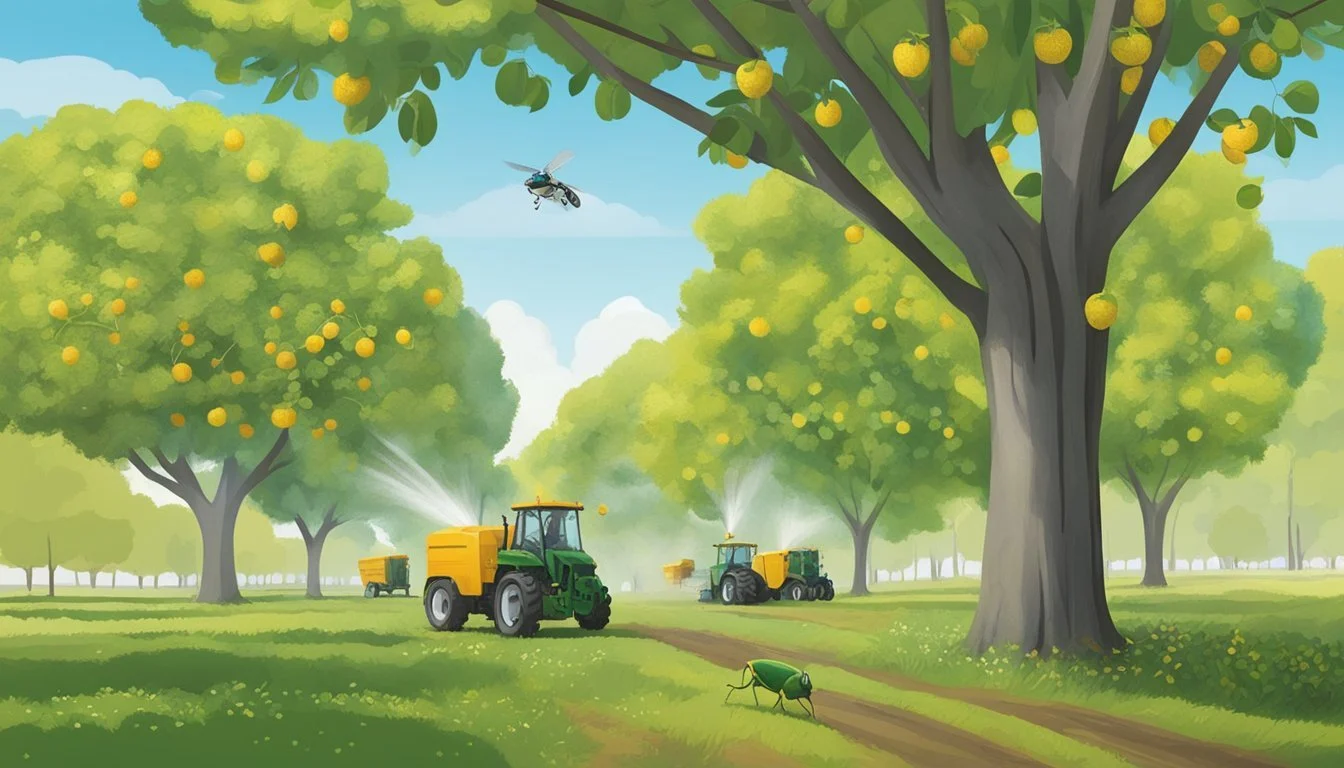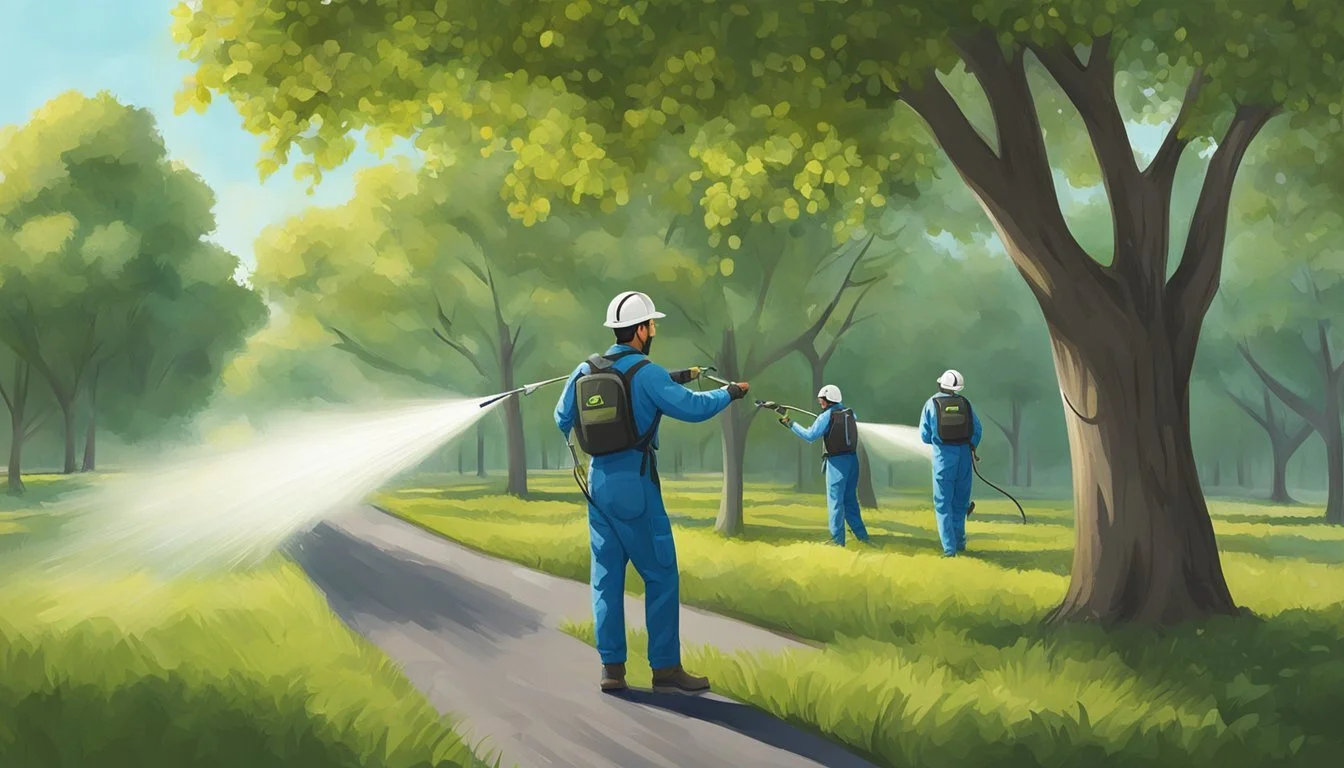Pest Control for Walnut Groves
Effective Strategies and Solutions
Pest control is crucial for maintaining healthy walnut groves, as pests can cause significant damage to both the quality and quantity of the harvest. Walnut trees are susceptible to a variety of pests including insects, rodents, and diseases that can impair tree health and nut production. Effective pest management in walnut groves involves the identification of pest species, monitoring their populations, and implementing control measures that are environmentally sound and economically feasible.
Integrated pest management (IPM) strategies are often employed in walnut groves to minimize the use of chemical pesticides and to focus on long-term prevention of pests or their damage through a combination of techniques such as biological control, habitat manipulation, and use of resistant varieties. By understanding the life cycles of pests and their interaction with the environment, walnut growers can manage pest populations with minimal harm to people, property, and the ecosystem.
Effective pest control in walnut groves also leans heavily on timely action. Proactive monitoring and targeted interventions can prevent small pest issues from escalating into infestations that threaten the livelihood of the grove. This often requires a blend of cultural practices, such as good sanitation and proper irrigation, along with the judicious use of chemical treatments when necessary. The ultimate goal is to protect these valuable trees, ensure bountiful harvests, and preserve the quality of the nuts produced.
Understanding Pest Dynamics in Walnut Groves
Effective pest control is essential for maintaining the health and productivity of walnut groves. This section explores the various pests that can infest these groves, the factors that affect their populations, and the damage they can cause.
Common Pests in Walnut Groves
Walnut groves can be infested by a range of pests, including insects, rodents, and arachnids. Key insect pests include the walnut husk fly, which deposits eggs in the developing nuts, leading to larvae that can destroy the nutmeat. Rodents such as rats and mice can also cause significant damage by gnawing on tree bark, roots, and nuts, while spiders, though often beneficial by preying on harmful insects, can become pests under certain conditions.
Factors Influencing Pest Populations
The population dynamics of pests in a walnut grove are influenced by various factors including the climate, the seasonal life cycles of the pests, and agricultural practices. In California, where many walnut groves are located, the warm climate can accelerate pest life cycles, potentially leading to rapid increases in pest populations. Integrated pest management practices aim to understand and mitigate these factors to protect walnut groves from severe infestations.
Impact of Pests on Walnut Groves
Pests can inflict serious damage on walnut groves, from the destruction of nuts and foliage to the weakening of tree health overall. Infestation can result in decreased yield, compromised nut quality, and if left unchecked, could threaten the viability of the walnut grove. Evaluating and managing pest populations is therefore critical to preventing the destruction and ensuring the longevity and productivity of these valuable agricultural resources.
Preventative Pest Management Strategies
Effective pest management in walnut groves hinges on proactive and preventative measures. By implementing cultural, biological, and physical control methods, growers can foster an environment less susceptible to pest outbreaks, leading to a more sustainable orchard.
Cultural Control Techniques
Cultural control involves modifying the agricultural environment to suppress pest populations. One such technique is crop rotation, which disrupts pest life cycles by alternating host plants. Additionally, sanitation practices, such as removing fallen nuts and diseased plant material, minimize sources of pest infestation. By maintaining diverse ground cover, growers encourage the presence of natural predators while suppressing weeds that can harbor pests.
Biological Pest Control and its Advantages
Biological pest control integrates natural predators, parasites, or pathogens into the agroecosystem to manage pest populations. This strategy emphasizes the benefits of introducing organisms such as predatory insects, to target pests specific to walnut groves. It is both environmentally friendly and sustainable, being a pivotal component of integrated pest management (IPM). Biological control also reduces reliance on chemical pesticides, preserving the natural balance within the orchard.
Physical and Mechanical Control Methods
Physical and mechanical strategies are direct interventions for pest control, ranging from simple handpicking to sophisticated deployment of barriers and traps. Examples include using netting to protect crops from birds and installing insect traps for detection and monitoring. These methods can be highly specific, avoiding non-target species and ecological disruption. Regular monitoring through trapping and visual inspections allows for timely and targeted interventions, minimizing damage while being mindful of the natural environment.
Chemical Control: Insecticides and Rodenticides
Effective pest management in walnut groves often involves the use of specific chemicals designed to target pests without causing undue harm to the trees and the environment. This section delves into selecting appropriate treatments, application methods, and understanding pest resistance.
Choosing the Right Chemical Treatments
When choosing chemical treatments for a walnut grove, growers must consider the type of pests present and their life cycle stages. Insecticides specifically formulated for walnuts, such as those geared towards controlling the walnut husk fly, should be selected based on their effectiveness in disrupting the life cycle of the target pests while minimizing impact on beneficial organisms and the surrounding ecosystem.
Application Techniques for Chemical Controls
The application of chemicals requires precision to ensure effective pest control while protecting non-target species. Techniques vary, with some chemicals requiring direct application onto the tree, including the trunk and foliage, and others around the base to prevent rodents from harming the trees. For instance, the Pest Management Guide for Walnuts in the Willamette Valley recommends specific timings and methods for applying fungicides and insecticides.
Understanding Chemical Resistance in Pests
Pests can develop resistance to chemical controls, making them less effective over time. Growers must employ strategies like rotating chemicals with different modes of action to prevent this. Detection of resistance involves monitoring pest populations' response to treatments and adapting management tactics accordingly. Regularly updated pest control guides provide insights into managing resistance.
By adhering to the guidelines for choosing and applying chemical treatments and monitoring for potential resistance, walnut growers can maintain effective pest management in their groves.
Integrated Pest Management in Walnut Groves
Integrated Pest Management (IPM) is a sophisticated and environmentally friendly approach essential for maintaining healthy walnut groves. It hinges on continuous monitoring and the strategic addressing of pest issues with tailored solutions.
Principles of Integrated Pest Management
The foundation of Integrated Pest Management in walnut groves centers on the balance between effective pest control and environmental considerations. The principles of IPM include:
Identification: Accurate identification of pests is critical to managing them effectively.
Prevention: Prioritizing cultural practices that prevent pest populations from becoming problematic.
Education: Staying informed about pest life cycles and how they interact with the environment.
By adhering to these principles, growers can maintain control over pest issues while also being stewards of the land.
Monitoring and Determining Action Thresholds
Monitoring is the backbone of any IPM program. It involves regular and rigorous inspection of walnut groves to track pest populations. Action thresholds are then determined, which are:
Defined levels: Specifying the point at which pest populations will cause economic damage.
Informed decisions: Using thresholds to decide when to implement control methods.
This process ensures that interventions are made only when necessary, reducing the overall reliance on chemical controls.
Implementing a Tailored IPM Plan
Developing and implementing a tailored IPM plan involves a series of steps that reflect the specific needs of each walnut grove.
Custom Strategies: Employing techniques such as biological control, habitat manipulation, and using resistant varieties.
Chemical Selection: When necessary, choosing the least disruptive treatments to non-target organisms and the environment.
Evaluation: Continually assessing the effectiveness of the IPM plan and adjusting as needed.
A tailored IPM plan ensures that pest management in walnut groves is precise, targeted, and minimizes harm to ecosystems.
Selecting a Professional Pest Control Service
Choosing the right professional pest control service requires careful consideration of several factors. It is essential to ensure that the company you select is equipped to handle the specific pest issues in your walnut grove.
What to Look for in Pest Control Companies
Reputation and Credentials: Research pest control companies with a proven track record. They should be licensed and have positive reviews from past clients. Certifications from recognized industry organizations can also be a mark of a reputable company.
Experienced Technicians: The company should employ knowledgeable and experienced exterminators. A skilled technician will be able to provide effective rodent control, mosquito control, and termite control services. Look for companies whose staff are trained in the latest pest detection and extermination techniques.
Understanding the Scope of Services Offered
Comprehensive Services: A good pest control company offers a range of services to deal with various pests. These services often include residential and commercial extermination, as well as specialized treatments for specific pests such as termites.
Customized Plans: Each walnut grove may require a different approach. Whether it's a one-time service or ongoing pest management, companies should offer tailored solutions that address the unique needs of your property.
The Importance of Regular Termite Inspections
Prevention and Detection: Regular termite inspections by a professional are crucial in preventing significant damage to your walnut trees. These inspections can lead to early detection, which is key in managing termite populations.
Termite Control Plans: If termites are detected, a professional pest control service can implement a termite control plan. This plan may include treatments such as soil application, wood treatments, or bait systems designed to eliminate termites and prevent future infestations.
Specific Pest Control Methods
The management of pests in walnut groves is a precise practice involving various techniques to target specific pests. Implementing effective strategies ensures the health of the trees and the safety of the harvest.
Termite Control and Extermination
Termites pose a significant threat to walnut trees by damaging the structural integrity of the wood. To combat termite infestations, one should use bait stations that contain slow-acting insecticides. This method is designed to be carried by worker termites back to the colony, ensuring the extermination of the population. Professional exterminators typically perform an assessment before creating a tailored termite control plan.
Ant Control Techniques
Ant infestations disrupt the ecological balance and can aid in spreading other pests. Ant control is commonly achieved through the use of ant baits and insecticide barriers. Baits serve to eliminate the colony over time as ants carry the poisoned bait back to their nests. It is important to identify the specific ant species to use the most effective treatment.
Effective Rodent Control Strategies
Rodents like rats and mice can cause significant damage to walnut groves by gnawing on bark, which can lead to tree diseases. Effective rodent control strategies include the installation of traps and the use of rodenticides. Traps should be strategically placed along known rodent paths while maintaining safety for non-target species. Bait stations can also be used, providing a secure way to deploy rodenticides.
Addressing Invasions of Spiders and Ticks
Despite some spiders being beneficial predators of insects, an overabundance can become problematic. Similarly, ticks carry diseases such as Lyme disease. To manage these pests, spider control and tick control methods often include the use of environmental management to remove habitats and the application of acaricides in targeted areas. Regular monitoring is crucial to respond swiftly to any signs of infestation.
Frequently Asked Questions
Effective pest management in walnut groves is essential to safeguard the quality of the crop. Addressing common pests such as walnut husk flies, codling moths, and aphids through targeted strategies ensures the health and productivity of the orchards.
How can infestations of Rhagoletis completa in walnut groves be effectively managed?
To manage Rhagoletis completa, also known as the walnut husk fly, growers should implement regular monitoring. Traps are used to detect adult flies, and applying insecticides timed to the flies' life cycle can effectively reduce their populations.
What are the best practices for preventing codling moth damage in walnut trees?
For preventing codling moth damage, an integrated pest management approach is recommended. This includes pheromone trap monitoring for adult moths, timely application of insecticides, and maintaining orchard hygiene by removing infected nuts and debris that could harbor larvae.
What methods are recommended for controlling aphid populations in walnut orchards?
Controlling aphid populations requires a combination of biological and chemical methods. Introducing natural predators like ladybugs and lacewings can help, along with the careful use of specific insecticides that target aphids without harming beneficial insects.
How can one effectively treat fall webworm moth infestations in walnut groves?
For fall webworm moth control, mechanical removal of the webs and larvae may be necessary for smaller infestations. Insecticidal sprays are also effective, but they must be applied when the larvae are small and actively feeding for the best results.
What treatments are effective for walnut husk fly larvae?
To target walnut husk fly larvae, insecticidal sprays should be applied when the majority of eggs have hatched but before the larvae have entered the husks. Soil treatments after harvest can also help to control the overwintering population.
How can black walnut curculio be controlled within walnut plantations?
Managing black walnut curculio involves regular orchard monitoring and the application of insecticides when adult activity is detected. Keeping the orchard floor clean and destroying fallen nuts can help reduce the chances of reinfestation.








